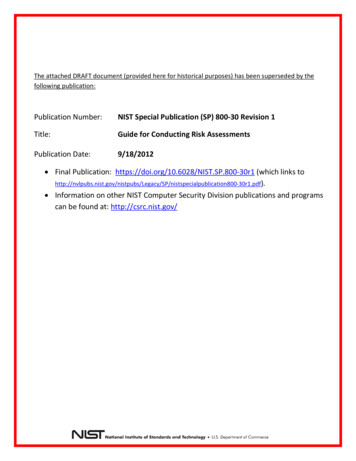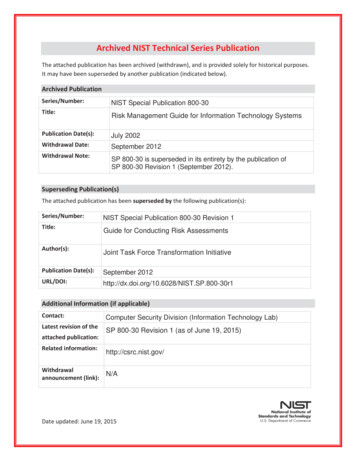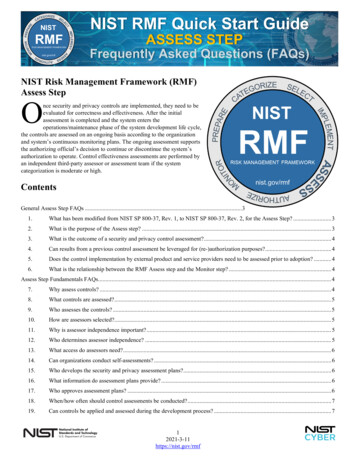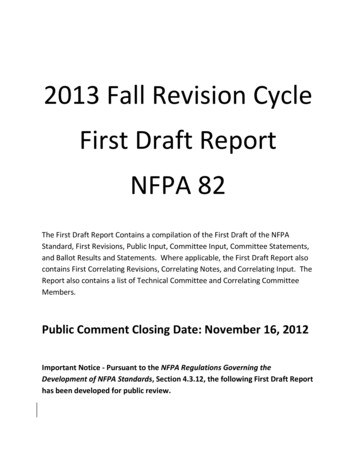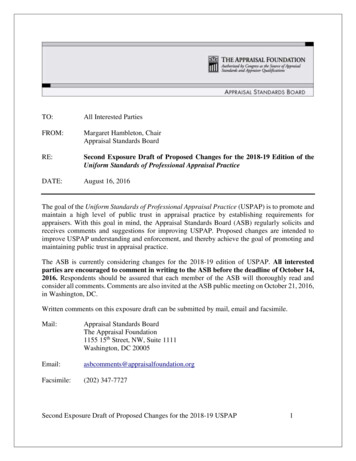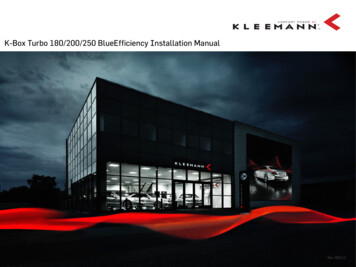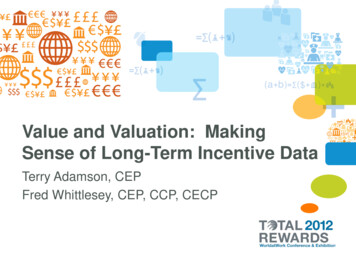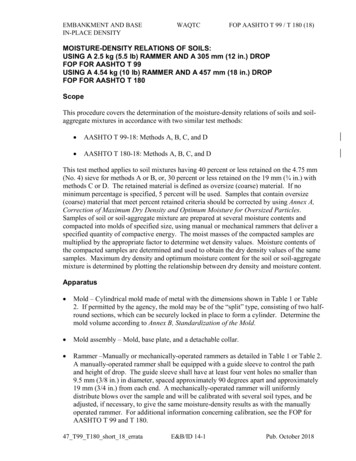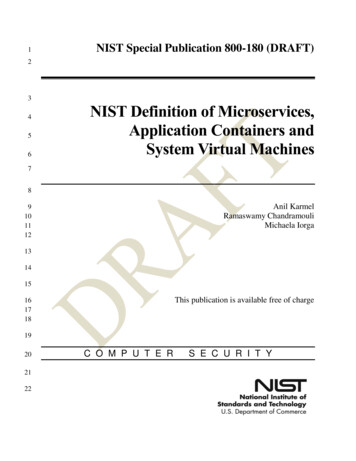
Transcription
1NIST Special Publication 800-180 (DRAFT)23456NIST Definition of Microservices,Application Containers andSystem Virtual Machines78Anil KarmelRamaswamy ChandramouliMichaela Iorga9101112131415This publication is available free of charge16171819202122C O M P U T E RS E C U R I T Y
23NIST Special Publication 800-180 (DRAFT)24252627NIST Definition of Microservices,Application Containers andSystem Virtual 49505152Anil KarmelC2 Labs, Inc.Reston, VARamaswamy ChandramouliMichaela Iorga.Computer Security DivisionInformation Technology LaboratoryThis publication is available free of chargeFebruary 2016U.S. Department of CommercePenny Pritzker, SecretaryNational Institute of Standards and TechnologyWillie May, Under Secretary of Commerce for Standards and Technology and Director
53Authority54555657585960This publication has been developed by NIST in accordance with its statutory responsibilities under theFederal Information Security Modernization Act (FISMA) of 2014, 44 U.S.C. § 3541 et seq., Public Law(P.L.) 113-283. NIST is responsible for developing information security standards and guidelines,including minimum requirements for federal information systems, but such standards and guidelines shallnot apply to national security systems without the express approval of appropriate federal officialsexercising policy authority over such systems. This guideline is consistent with the requirements of theOffice of Management and Budget (OMB) Circular A-130.616263646566Nothing in this publication should be taken to contradict the standards and guidelines made mandatoryand binding on federal agencies by the Secretary of Commerce under statutory authority. Nor shouldthese guidelines be interpreted as altering or superseding the existing authorities of the Secretary ofCommerce, Director of the OMB, or any other federal official. This publication may be used bynongovernmental organizations on a voluntary basis and is not subject to copyright in the United States.Attribution would, however, be appreciated by NIST.676869National Institute of Standards and Technology Special Publication 800-1807071This publication is available free of charge72737475767778798081828384Certain commercial entities, equipment, or materials may be identified in this document in order to describe anexperimental procedure or concept adequately. Such identification is not intended to imply recommendation orendorsement by NIST, nor is it intended to imply that the entities, materials, or equipment are necessarily the bestavailable for the purpose.85Comments on this publication may be submitted to:86Public comment period: February 18, 2016 through March 18, 20168788899091All comments are subject to release under the Freedom of Information Act (FOIA).Natl. Inst. Stand. Technol. Spec. Publ. 800-180, 12 pages (February 2016)CODEN: NSPUE2There may be references in this publication to other publications currently under development by NIST inaccordance with its assigned statutory responsibilities. The information in this publication, including concepts andmethodologies, may be used by federal agencies even before the completion of such companion publications. Thus,until each publication is completed, current requirements, guidelines, and procedures, where they exist, remainoperative. For planning and transition purposes, federal agencies may wish to closely follow the development ofthese new publications by NIST.Organizations are encouraged to review all draft publications during public comment periods and provide feedbackto NIST. All NIST Computer Security Division publications, other than the ones noted above, are available athttp://csrc.nist.gov/publications.National Institute of Standards and TechnologyAttn: Computer Security Division, Information Technology Laboratory100 Bureau Drive (Mail Stop 8930) Gaithersburg, MD 20899-8930Email: sec-cloudcomputing@nist.gov92ii
93Reports on Computer Systems Technology949596979899100101102103The Information Technology Laboratory (ITL) at the National Institute of Standards andTechnology (NIST) promotes the U.S. economy and public welfare by providing technicalleadership for the Nation’s measurement and standards infrastructure. ITL develops tests, testmethods, reference data, proof of concept implementations, and technical analyses to advancethe development and productive use of information technology. ITL’s responsibilities include thedevelopment of management, administrative, technical, and physical standards and guidelines forthe cost-effective security and privacy of other than national security-related information infederal information systems. The Special Publication 800-series reports on ITL’s research,guidelines, and outreach efforts in information system security, and its collaborative activitieswith industry, government, and academic organizations.104Abstract105106107108109110111Many variations and definitions of application containers exist in industry, causing considerableconfusion amongst those who attempt to explain what a container is. This document serves toprovide a NIST-standard definition to application containers, microservices which reside inapplication containers and system virtual machines. Furthermore, this document explains thesimilarities and differences between a Services Oriented Architecture (SOA) and Microservicesas well as the similarities and differences between System Virtual Machines and ApplicationContainers.112Keywords113114Application Containers; System Virtual Machines; Microservices; Services OrientedArchitectureiii
115Acknowledgements116Audience117118The intended audience of this document is system planners, program managers, technologists, and othersas consumers or providers of cloud services.119Compliance with NIST Standards and 33134135136137The National Institute of Standards and Technology (NIST) developed this document in furtherance of itsstatutory responsibilities under the Federal Information Security Management Act (FISMA) of 2014,Public Law 113-283.NIST is responsible for developing standards and guidelines, including minimum requirements, forproviding adequate information security for all agency operations and assets; but such standards andguidelines shall not apply to national security systems. This guideline is consistent with the requirementsof the Office of Management and Budget (OMB) Circular A-130, Section 8b(3), “Securing AgencyInformation Systems,” as analyzed in A-130, Appendix IV: Analysis of Key Sections. Supplementalinformation is provided in A-130, Appendix III.This guideline has been prepared for use by Federal agencies. It may be used by nongovernmentalorganizations on a voluntary basis and is not subject to copyright, though attribution is desired.Nothing in this document should be taken to contradict standards and guidelines made mandatory andbinding on Federal agencies by the Secretary of Commerce under statutory authority, nor should theseguidelines be interpreted as altering or superseding the existing authorities of the Secretary of Commerce,Director of the OMB, or any other Federal official.138iv
139Executive Summary140141142143Ubiquitous deployment of server or hardware virtualization has created a good understanding ofthe semantics of the term Virtual Machines (VMs). Similarly, the web services deploymentparadigm that has been in vogue since the 1990’s to the 2000’s has created a fair agreement onwhat constitutes a Service-Oriented Architecture (SOA).144145146147148149150However, a relatively recent trend is operating system-level virtualization using the concept ofapplication containers that run as isolated user space processes on top of an OS’s kernel. Becauseof the close similarity between the core function provided by application containers and VMs(i.e., isolation), there is a need to provide a formal definition of both these terms and outline theirsimilarities and differences. Further, these application containers are self-contained applicationpackages and are built using OS/library/binary components each providing an OS-levelcapability.151152153154155156Applications are decomposed into discrete components based on capabilities as opposed toservices and placed into application containers with the resulting deployment paradigm called aMicroservices Architecture. This Microservices Architecture, in turn, bears many similaritieswith SOAs in terms of their modular construction and hence formal definitions for these twoterms are also needed in order to promote a common understanding among various stakeholdersin this technology space such as system architects, integrators etc.v
NIST SP 800-180NIST Definition of Microservices, Application Containersand System Virtual Machines157Table of Contents158Executive Summary . v1591Introduction . 11602Background: Service-Oriented Architecture . 21613Definition of Microservices . 21624Similarities and Differences between SOA and Microservices . 21635Definition of Application Containers . 31646Definition of System Virtual Machines (S-VM) . 31657Similarities and Differences between S-VMs and Application Containers . 3166167List of Appendices168Appendix A— Acronyms . 4169Appendix B— References . 5170171List of Figures172Figure 1 – Differences between S-VMs and Application Containers . 3173174List of Tables175Table 1 – Comparison of Services Oriented Architecture and Microservices . 2176vi
NIST SP 800-180NIST Definition of Microservices, Application Containersand System Virtual Machines1771Introduction178179180181182183184185A trend since the early 2000’s in data centers used for in-house enterprise applications and cloudcomputing services is the increasing adoption of Hardware or Server Virtualization. Hardwarevirtualization enables running multiple computing stacks called System Virtual Machines (SVMs) on a single physical host. A S-VM in the context of hardware virtualization is made up ofa complete computing stack (or engine) consisting of one or more applications, OperatingSystem (called the Guest OS) and virtual hardware. S-VMs are able to perform their tasks due toan intervening hardware emulation layer or hypervisor that runs between the S-VMs and thehardware of the physical host.186187188189190191192193194195Another trend is to virtualize applications at the OS layer. Just like multiple S-VMs run on thesame physical hardware, in this context, multiple instances of an entity called “ApplicationContainers” run on top of an OS’s kernel in user space. Just like hardware virtualization allowsmultiple OS instances to run on a single physical host, application container technology allowsmultiple isolated user space instances (processes) to be run on a single host. Applicationcontainers are made of up application code (e.g., webserver or DBMS server) which has accessto a collection of libraries/binaries that represent an OS’s core capabilities. Each librarycomponent provides a traditional OS function such as memory, namespace and processes neededfor that application code to work. The application container, when deployed, provides anexecution environment for applications in the form of isolated processes.196197198199200201Application components that are placed into a container leverage a Microservices architecture. AMicroservices architecture can be contrasted with a Service-oriented architecture (SOA) whereinMicroservices consist of small, stateless, loosely coupled and isolated processes built aroundcapabilities as opposed to services. Microservices are independently deployable in ApplicationContainers, use less resources and can be created, destroyed, started and stopped far faster thanin a SOA.202203204205206207Based on the discussion above, it should be clear that we need a formal definition of the buildingblocks of these emerging technologies such as Application Containers & Microservicesarchitecture as well as their closely related counterparts – S-VMs & SOA along with anexplanation of similarities and differences. The objective of this document is to provide thosedefinitions, similarities and differences so as to create a common understanding of the semanticsof these terms.1
NIST SP 800-180NIST Definition of Microservices, Application Containersand System Virtual Machines2082209210211212213214Assembling an enterprise-scale solutions or individual system from distributed services is a wellestablished architectural approach referred to as service-oriented architecture (SOA) [2]. A SOAis an architectural pattern for integrating business processes and supporting IT infrastructurewherein application components are decomposed into self-contained services that communicatewith each other using a communications protocol and a set of well-defined ApplicationProgramming Interfaces (APIs), independent of any vendor, product or technology.215SOA allows services to be reused and combined to address changing business priorities.2163217218219220Microservices: A microservice is a basic element that results from the architecturaldecomposition of an application’s components into loosely coupled patterns consisting of selfcontained services that communicate with each other using a standard communications protocoland a set of well-defined APIs, independent of any vendor, product or technology.221222223Microservices are built around capabilities as opposed to services, builds on SOA and isimplemented using Agile techniques. Microservices are typically deployed inside ApplicationContainers.2244225SOA and Microservices share several similarities and differences that are outlined below.226Background: Service-Oriented ArchitectureDefinition of MicroservicesSimilarities and Differences between SOA and MicroservicesTable 1 – Comparison of Services Oriented Architecture and MicroservicesServices Oriented ArchitectureMicroservicesSelf-contained, monolithic servicesSmall, decomposed, isolated andindependently deployable servicesCommunications between servicesoccur through an enterprise servicebusCommunications between servicesoccur through lightweight, standardcommunications protocols andinterfacesStateful and requires mapping ofservice dependencies when changesare introducedStateless and less fragile whenchanges are introducedLonger start/stop timesQuick start/stop timesBuilt around servicesBuilt around capabilities2
NIST SP 800-180NIST Definition of Microservices, Application Containersand System Virtual Machines2275Definition of Application Containers228229Application Containers: An Application Container is a construct designed to package and runan application or its’ components running on a shared Operating System.230231232Application Containers are isolated from other Application Containers and share the resources ofthe underlying Operating System, allowing for efficient restart, scale-up or scale-out ofapplications across clouds. Application Containers typically contain Microservices.2336234235236System Virtual Machines: A System Virtual Machine (S-VM) is a software implementation of acomplete system platform that supports the execution of a complete operating system andcorresponding applications in a cloud.237238Each S-VM serves as an efficient, isolated duplicate of a real machine running on a cluster ofphysical machines.2397240241242243244S-VMs abstract the Operating System from the underlying hardware, allowing for multipleOperating Systems and Application to share a single system’s physical compute resources.Application Containers abstract the Application from the underlying Operating System, allowingfor multiple Applications to share a single system’s Operating System and underlying physicalcompute resources245246The following figure depicts the difference between System Virtual Machines and ApplicationContainersDefinition of System Virtual Machines (S-VM)Similarities and Differences between S-VMs and Application Containers247248Figure 1 – Differences between S-VMs and Application Containers3
NIST SP 800-180249250NIST Definition of Microservices, Application Containersand System Virtual MachinesAppendix A—AcronymsSelected acronyms and abbreviations used in this paper are defined below.APIApplication Programming InterfaceOSOperating SystemSOAService-Oriented ArchitectureS-VMSystem Virtual Machine2512524
NIST SP 800-180253NIST Definition of Microservices, Application Containersand System Virtual MachinesAppendix B—References[1]Federal Information Security Management Act of 2002, Pub. L. 107-347(Title III), 116 Stat 2946. AW-107publ347.pdf.[2]Executing SOA: A Practical Guide for the Service-Oriented Architect, IBMPress, 2008, 240pp. https://books.google.com/books?id VIrz5v4MMkgC2545
23 NIST Special Publication 800-180 (DRAFT) 24 25 NIST Definition of Microservices, 26 Application Containers and 27 System Virtual Machines 28 29 Anil Karmel 30 C2 Labs, Inc. 31 Reston, VA 32 33 Ramaswamy Chandramouli 34 Michaela Iorga. 35 Computer Security Division 36 Information Technology Laboratory 37 38 39 This publication is available free of charge
